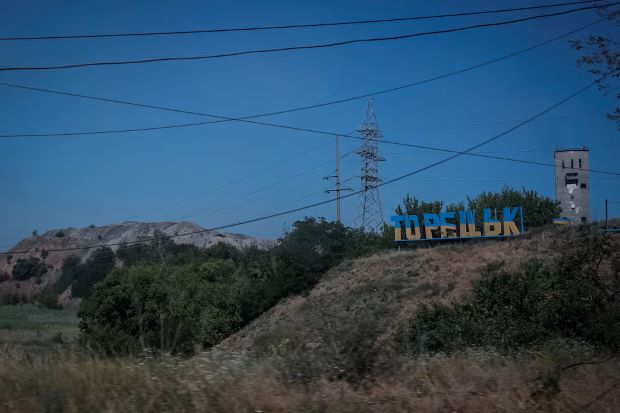After key town falls in Ukraine’s east, Russian forces push into another
By Constant Méheut
KYIV — A week after Russia captured Vuhledar, a town that anchored Ukraine’s defences in the country’s southeast, Moscow’s forces are continuing to advance in the area, pushing into or flanking several towns as they try to break through Ukrainian lines.
Russian troops have now entered Toretsk, a city about 50 miles north of Vuhledar, and are advancing toward its centre, according to battlefield maps compiled by independent groups analyzing combat footage. A Ukrainian army spokesperson, Anastasia Bobovnikova, said late Monday (7) that Russia had entered the city, noting that “fighting is taking place literally at every entrance” to it.
The Russian army has also made small advances along the jagged, curving front line that stretches from Toretsk to Vuhledar in eastern Ukraine’s Donetsk region, closing in on several strategic towns and cities, the battlefield maps show.
The fierce fighting in the area reflects the Kremlin’s long-standing goal of capturing all of the Donetsk region, which it already partly controls. “This is clearly what the Russians are aiming at,” said Franz-Stefan Gady, a Vienna-based military analyst. “As a result, this is where the heaviest fighting is happening.”
The flurry of activity in eastern Ukraine contrasts with the situation in the Kursk region in western Russia, which Ukrainian forces partly invaded in August. Ukraine’s troops made swift gains early in the offensive, some of which were reversed by Russian counterattacks last month. The front line has recently stabilized, with each side making only marginal advances.
Russia remains far from capturing the entire Donetsk region. As of now, it controls about two-thirds of the area. To seize the remaining third, it would need to break through several Ukrainian defensive lines of trenches and anti-tank ditches, and battle its way through densely populated urban centres — a gruelling fight that U.S. officials believe the Russian army cannot successfully wage in the short term.
Still, the slow but steady advance of Russian troops in the Donetsk region since the beginning of the year has enabled the Kremlin to capture or threaten several Ukrainian bastions that hold the keys to Ukraine’s defence of the area, because they are densely fortified and located on advantageous terrain like high ground. These gains have positioned Moscow favourably, giving it the potential to fully seize the region in the future, military analysts say.
The fall of the hilltop city of Toretsk, for example, would allow Moscow to advance on a critical highway connecting several cities that form Ukraine’s main defence belt in the part of the Donetsk region it still controls. Cutting off the road would greatly complicate the Ukrainian military logistics in the area.
“The situation on the Toretsk front remains the hottest,” Bobovnikova told Ukrainian television Monday.
To the southwest of Toretsk, Russian forces are widening a bulge they have cut into Ukrainian defences, as they push toward the strategic city of Pokrovsk, a railway and road junction. Instead of directly attacking Pokrovsk, which is protected by several lines of trenches and anti-tank ditches, Russian troops are trying to flank it by seizing less fortified territory to the south.
Pasi Paroinen, a military expert for the Finland-based Black Bird Group, which analyzes satellite images of the battlefield and combat footage, said Ukraine did not have strong defensive lines in the area directly south of Pokrovsk, allowing Russia to step into the breach. In the past two weeks, its forces have captured several villages and settlements there.
“It would make sense for Russia to try to envelop Pokrovsk from the south,” Paroinen said.
Paroinen and Gady said that Russian forces had increasingly employed encirclement tactics to pressure Ukrainian troops into retreating. They push through weak points in Ukrainian defences, and capture narrow strips of land to form pincers around Ukrainian positions before tightening the noose, they said.
Russian troops have now partly succeeded in forming a semicircle around Selydove, a town about 10 miles southeast of Pokrovsk. Its capture would facilitate Russian attempts to flank Pokrovsk.
Vuhledar also fell last week after being caught in a pincer movement, forcing Ukrainian soldiers still in the town to withdraw quickly as Russian forces closed in from three directions.
Serhii Kuzan, chair of the Ukrainian Security and Cooperation Centre, a nongovernmental research group, said the capture of Vuhledar would complicate the defence of the town of Kurakhove, another Ukrainian bastion in the Donetsk region.
Kurakhove could find itself caught in a large pincer movement, with Russian forces advancing from the south via Vuhledar and from the north through Ukrainsk, another town that they captured last month.
“The Russians have been attacking the area for a long time, and it is one of the most active sections of the front along with the Pokrovsk section,” Kuzan said about Kurakhove.
In recent days, Russian forces have also resumed attacks in southern Ukraine, where there had been a relative lull in fighting after the Ukrainian counteroffensive culminated last fall.
Ukrainian officials reported that Russia had deployed new units to the area in preparation for future assaults. Russian troops recently entered the village of Kamianske, south of the city of Zaporizhzhia, and have launched assaults in other parts of the southern front.
While it is too early to determine the outcome of these attacks, analysts suggest that they may be aimed at stretching Ukrainian forces and diverting some away from the Donetsk region, as well as targeting supply routes running from the south to the eastern front.
-New York Times
A damaged sign that reads ‘Toretsk, painted in the colours of the Ukrainian flag, near a coal mine building and a colliery spoil, in the town of Toretsk, amid Russia’s attack on Ukraine, near a front line in Donetsk region, in Ukraine on July 3, 2024 – Alina Smutko/Reuters/File



Comments are closed, but trackbacks and pingbacks are open.